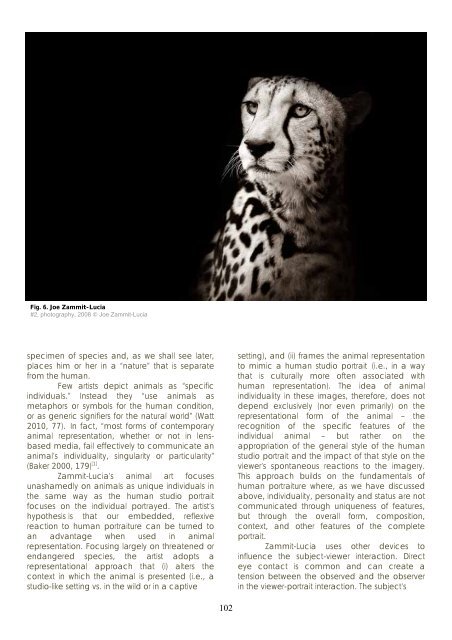Marketing Animals - Antennae The Journal of Nature in Visual Culture
Marketing Animals - Antennae The Journal of Nature in Visual Culture
Marketing Animals - Antennae The Journal of Nature in Visual Culture
Create successful ePaper yourself
Turn your PDF publications into a flip-book with our unique Google optimized e-Paper software.
Fig. 6. Joe Zammit-Lucia<br />
#2, photography, 2008 Joe Zammit-Lucia<br />
specimen <strong>of</strong> species and, as we shall see later,<br />
places him or her <strong>in</strong> a “nature” that is separate<br />
from the human.<br />
Few artists depict animals as “specific<br />
<strong>in</strong>dividuals.” Instead they “use animals as<br />
metaphors or symbols for the human condition,<br />
or as generic signifiers for the natural world” (Watt<br />
2010, 77). In fact, “most forms <strong>of</strong> contemporary<br />
animal representation, whether or not <strong>in</strong> lensbased<br />
media, fail effectively to communicate an<br />
animal’s <strong>in</strong>dividuality, s<strong>in</strong>gularity or particularity”<br />
(Baker 2000, 179) [1] .<br />
Zammit-Lucia’s animal art focuses<br />
unashamedly on animals as unique <strong>in</strong>dividuals <strong>in</strong><br />
the same way as the human studio portrait<br />
focuses on the <strong>in</strong>dividual portrayed. <strong>The</strong> artist’s<br />
hypothesis is that our embedded, reflexive<br />
reaction to human portraiture can be turned to<br />
an advantage when used <strong>in</strong> animal<br />
representation. Focus<strong>in</strong>g largely on threatened or<br />
endangered species, the artist adopts a<br />
representational approach that (i) alters the<br />
context <strong>in</strong> which the animal is presented (i.e., a<br />
studio-like sett<strong>in</strong>g vs. <strong>in</strong> the wild or <strong>in</strong> a captive<br />
102<br />
sett<strong>in</strong>g), and (ii) frames the animal representation<br />
to mimic a human studio portrait (i.e., <strong>in</strong> a way<br />
that is culturally more <strong>of</strong>ten associated with<br />
human representation). <strong>The</strong> idea <strong>of</strong> animal<br />
<strong>in</strong>dividuality <strong>in</strong> these images, therefore, does not<br />
depend exclusively (nor even primarily) on the<br />
representational form <strong>of</strong> the animal – the<br />
recognition <strong>of</strong> the specific features <strong>of</strong> the<br />
<strong>in</strong>dividual animal – but rather on the<br />
appropriation <strong>of</strong> the general style <strong>of</strong> the human<br />
studio portrait and the impact <strong>of</strong> that style on the<br />
viewer’s spontaneous reactions to the imagery.<br />
This approach builds on the fundamentals <strong>of</strong><br />
human portraiture where, as we have discussed<br />
above, <strong>in</strong>dividuality, personality and status are not<br />
communicated through uniqueness <strong>of</strong> features,<br />
but through the overall form, composition,<br />
context, and other features <strong>of</strong> the complete<br />
portrait.<br />
Zammit-Lucia uses other devices to<br />
<strong>in</strong>fluence the subject-viewer <strong>in</strong>teraction. Direct<br />
eye contact is common and can create a<br />
tension between the observed and the observer<br />
<strong>in</strong> the viewer-portrait <strong>in</strong>teraction. <strong>The</strong> subject’s












